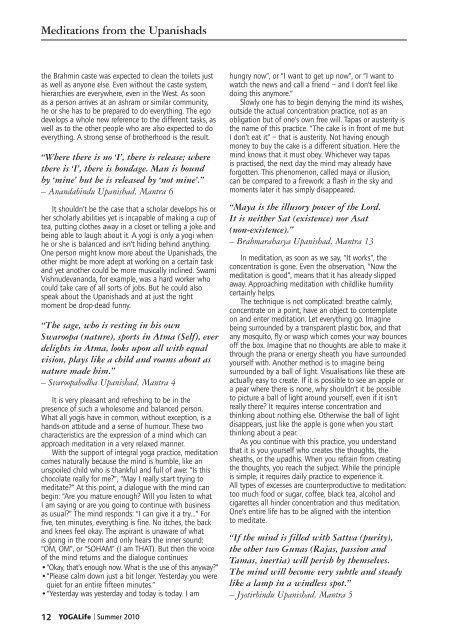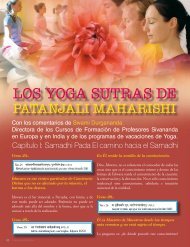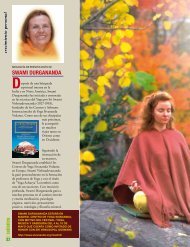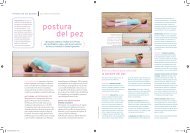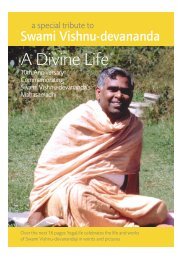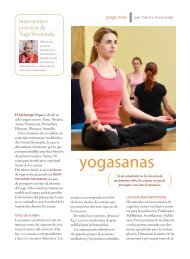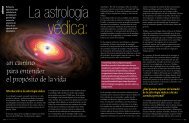YOGALife I Summer 2010 - Sivananda Yoga
YOGALife I Summer 2010 - Sivananda Yoga
YOGALife I Summer 2010 - Sivananda Yoga
You also want an ePaper? Increase the reach of your titles
YUMPU automatically turns print PDFs into web optimized ePapers that Google loves.
Meditations from the Upanishads<br />
the Brahmin caste was expected to clean the toilets just<br />
as well as anyone else. Even without the caste system,<br />
hierarchies are everywhere, even in the West. As soon<br />
as a person arrives at an ashram or similar community,<br />
he or she has to be prepared to do everything. The ego<br />
develops a whole new reference to the different tasks, as<br />
well as to the other people who are also expected to do<br />
everything. A strong sense of brotherhood is the result.<br />
“Where there is no ‘I’, there is release; where<br />
there is ‘I’, there is bondage. Man is bound<br />
by ‘mine’ but he is released by ‘not mine’.”<br />
– Anandabindu Upanishad, Mantra 6<br />
It shouldn’t be the case that a scholar develops his or<br />
her scholarly abilities yet is incapable of making a cup of<br />
tea, putting clothes away in a closet or telling a joke and<br />
being able to laugh about it. A yogi is only a yogi when<br />
he or she is balanced and isn’t hiding behind anything.<br />
One person might know more about the Upanishads, the<br />
other might be more adept at working on a certain task<br />
and yet another could be more musically inclined. Swami<br />
Vishnudevananda, for example, was a hard worker who<br />
could take care of all sorts of jobs. But he could also<br />
speak about the Upanishads and at just the right<br />
moment be drop-dead funny.<br />
“The sage, who is resting in his own<br />
Swaroopa (nature), sports in Atma (Self), ever<br />
delights in Atma, looks upon all with equal<br />
vision, plays like a child and roams about as<br />
nature made him.”<br />
– Svaroopabodha Upanishad, Mantra 4<br />
It is very pleasant and refreshing to be in the<br />
presence of such a wholesome and balanced person.<br />
What all yogis have in common, without exception, is a<br />
hands-on attitude and a sense of humour. These two<br />
characteristics are the expression of a mind which can<br />
approach meditation in a very relaxed manner.<br />
With the support of integral yoga practice, meditation<br />
comes naturally because the mind is humble, like an<br />
unspoiled child who is thankful and full of awe: “Is this<br />
chocolate really for me?”, “May I really start trying to<br />
meditate?” At this point, a dialogue with the mind can<br />
begin: “Are you mature enough? Will you listen to what<br />
I am saying or are you going to continue with business<br />
as usual?” The mind responds: “I can give it a try…” For<br />
five, ten minutes, everything is fine. No itches, the back<br />
and knees feel okay. The aspirant is unaware of what<br />
is going in the room and only hears the inner sound:<br />
“OM, OM”, or “SOHAM” (I am THAT). But then the voice<br />
of the mind returns and the dialogue continues:<br />
•“Okay, that’s enough now. What is the use of this anyway?”<br />
•“Please calm down just a bit longer. Yesterday you were<br />
quiet for an entire fifteen minutes.”<br />
•“Yesterday was yesterday and today is today. I am<br />
12<br />
<strong>YOGALife</strong> I <strong>Summer</strong> <strong>2010</strong><br />
hungry now”, or “I want to get up now”, or “I want to<br />
watch the news and call a friend – and I don’t feel like<br />
doing this anymore.”<br />
Slowly one has to begin denying the mind its wishes,<br />
outside the actual concentration practice, not as an<br />
obligation but of one’s own free will. Tapas or austerity is<br />
the name of this practice. “The cake is in front of me but<br />
I don’t eat it” – that is austerity. Not having enough<br />
money to buy the cake is a different situation. Here the<br />
mind knows that it must obey. Whichever way tapas<br />
is practised, the next day the mind may already have<br />
forgotten. This phenomenon, called maya or illusion,<br />
can be compared to a firework: a flash in the sky and<br />
moments later it has simply disappeared.<br />
“Maya is the illusory power of the Lord.<br />
It is neither Sat (existence) nor Asat<br />
(non-existence).”<br />
– Brahmarahasya Upanishad, Mantra 13<br />
In meditation, as soon as we say, “It works”, the<br />
concentration is gone. Even the observation, “Now the<br />
meditation is good”, means that it has already slipped<br />
away. Approaching meditation with childlike humility<br />
certainly helps.<br />
The technique is not complicated: breathe calmly,<br />
concentrate on a point, have an object to contemplate<br />
on and enter meditation. Let everything go. Imagine<br />
being surrounded by a transparent plastic box, and that<br />
any mosquito, fly or wasp which comes your way bounces<br />
off the box. Imagine that no thoughts are able to make it<br />
through the prana or energy sheath you have surrounded<br />
yourself with. Another method is to imagine being<br />
surrounded by a ball of light. Visualisations like these are<br />
actually easy to create. If it is possible to see an apple or<br />
a pear where there is none, why shouldn’t it be possible<br />
to picture a ball of light around yourself, even if it isn’t<br />
really there? It requires intense concentration and<br />
thinking about nothing else. Otherwise the ball of light<br />
disappears, just like the apple is gone when you start<br />
thinking about a pear.<br />
As you continue with this practice, you understand<br />
that it is you yourself who creates the thoughts, the<br />
sheaths, or the upadhis. When you refrain from creating<br />
the thoughts, you reach the subject. While the principle<br />
is simple, it requires daily practice to experience it.<br />
All types of excesses are counterproductive to meditation:<br />
too much food or sugar, coffee, black tea, alcohol and<br />
cigarettes all hinder concentration and thus meditation.<br />
One’s entire life has to be aligned with the intention<br />
to meditate.<br />
“If the mind is filled with Sattva (purity),<br />
the other two Gunas (Rajas, passion and<br />
Tamas, inertia) will perish by themselves.<br />
The mind will become very subtle and steady<br />
like a lamp in a windless spot.”<br />
– Jyotirbindu Upanishad, Mantra 5


